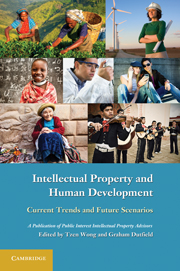Book contents
- Frontmatter
- Contents
- Boxes
- Contributors
- Foreword
- Preface
- Acknowledgements
- Acronyms and abbreviations
- Overview
- 1 Intellectual property through the lens of human development
- 2 Intellectual property and medicine: Towards global health equity
- 3 Food security and intellectual property rights: Finding the linkages
- 4 Trends and scenarios in the legal protection of traditional knowledge
- 5 Traditional cultural expressions: Preservation and innovation
- 6 Copyright and capability for education: An approach ‘from below’
- 7 Knowledge and education: Pro-access implications of new technologies
- 8 Cultural diversity and the arts: Contemporary challenges for copyright law
- 9 Scenario planning on the future of intellectual property: Literature review and implications for human development
- Appendix A Capability, opulence and utility1
- Appendix B Exploring alternative, collaborative models of innovation for medicines and vaccines1
- Appendix C Strategies and laws to promote traditional medicinal knowledge1
- Appendix D Educational use exceptions to copyright: A comparison among selected jurisdictions1
- Appendix E Copyright and contemporary art: A case study
- Index
Appendix E - Copyright and contemporary art: A case study
Published online by Cambridge University Press: 05 June 2012
- Frontmatter
- Contents
- Boxes
- Contributors
- Foreword
- Preface
- Acknowledgements
- Acronyms and abbreviations
- Overview
- 1 Intellectual property through the lens of human development
- 2 Intellectual property and medicine: Towards global health equity
- 3 Food security and intellectual property rights: Finding the linkages
- 4 Trends and scenarios in the legal protection of traditional knowledge
- 5 Traditional cultural expressions: Preservation and innovation
- 6 Copyright and capability for education: An approach ‘from below’
- 7 Knowledge and education: Pro-access implications of new technologies
- 8 Cultural diversity and the arts: Contemporary challenges for copyright law
- 9 Scenario planning on the future of intellectual property: Literature review and implications for human development
- Appendix A Capability, opulence and utility1
- Appendix B Exploring alternative, collaborative models of innovation for medicines and vaccines1
- Appendix C Strategies and laws to promote traditional medicinal knowledge1
- Appendix D Educational use exceptions to copyright: A comparison among selected jurisdictions1
- Appendix E Copyright and contemporary art: A case study
- Index
Summary
Copyright, the category of intellectual property (IP) most associated with the arts, is currently undergoing scrutiny from several sectors. Industry-oriented copyright owners, like music labels, are lobbying for more control of their songs. At the same time that digital rights management models are being reworked, the public is demanding greater access and less cost for copyrighted works. Authors and artists (who are not necessarily owners of their copyrighted work) are, ironically, not at the centre of this debate, although it is usually their creations over which these other parties are debating.
Indeed, the individual artist working in today's IP environment has a different set of concerns than does the agency that commodifies his or her work. The legal interests of creators and the legal interests of copyright holders can be very different, and many of the legal issues at stake (e.g. moral rights) are highly dependent upon the jurisdiction in which the artist is working. The following sections describe some of the situations where contemporary artists face challenging IP issues, including jurisdictional inconsistencies. For these purposes, ‘contemporary art’ comprises visual and multimedia creative expressions made after the Second World War.
- Type
- Chapter
- Information
- Intellectual Property and Human DevelopmentCurrent Trends and Future Scenarios, pp. 383 - 388Publisher: Cambridge University PressPrint publication year: 2010



